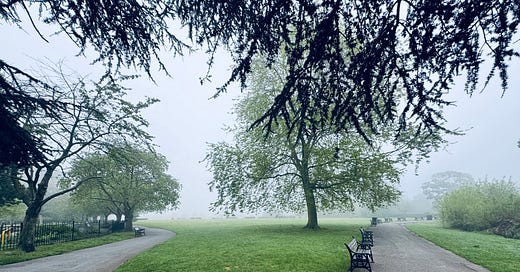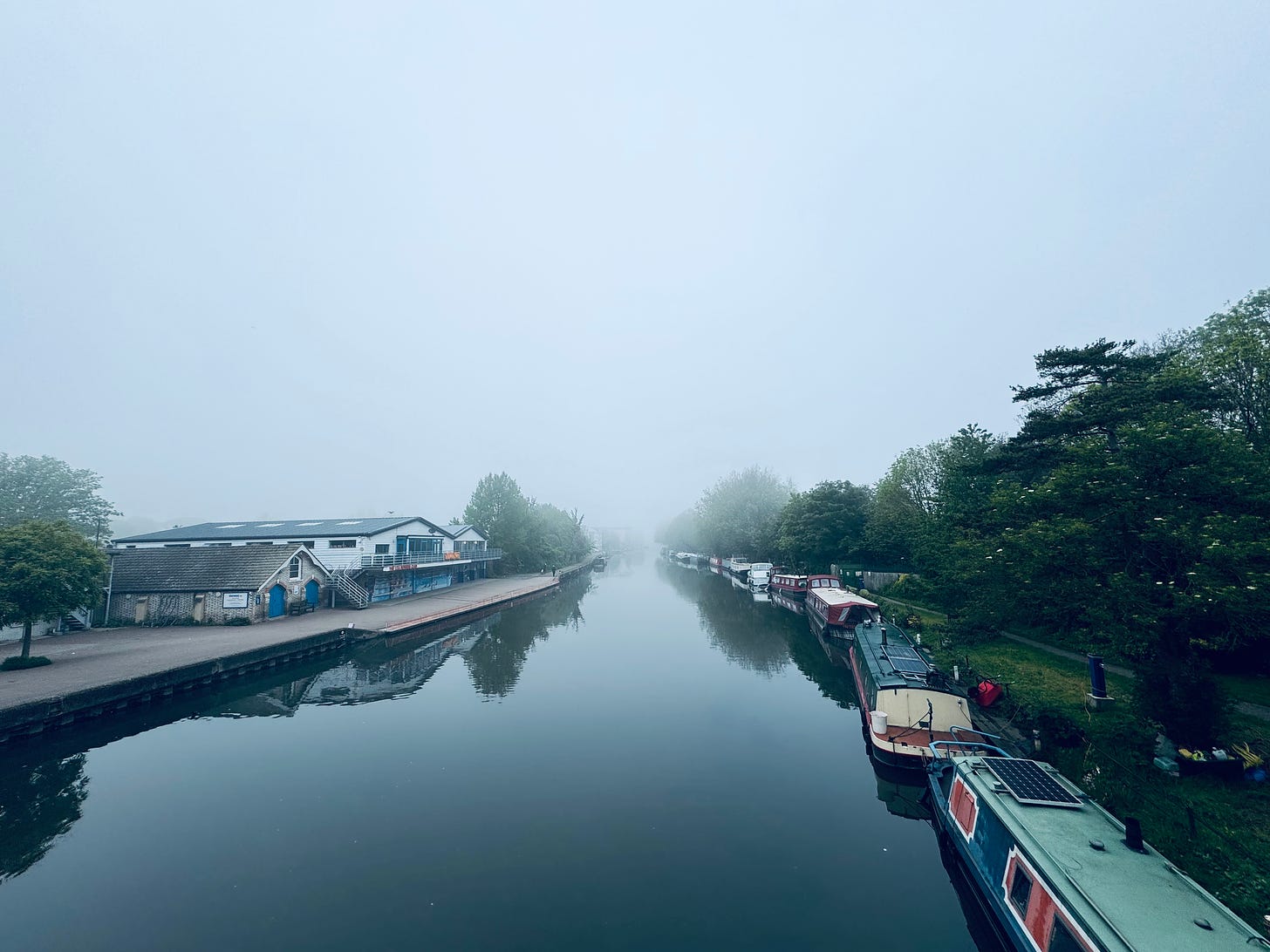Scatterbrain: a letter from the Peripatos
Walking; Werner Herzog, David Shields, the Chaplin Twins, and the falsity of memory (and memoirs)
These shoes are made for walking
The grey British spring has arrived, and I’ve been taking early morning walks. I wake up at 5:45am, get changed quickly, drink a glass of water, brush my teeth, leave the house and head in whichever direction I fancy, to walk briskly for an hour. This is a futile attempt to fend off old age and death but I’d be lying if I said I don’t enjoy my walks. Werner Herzog, in his On Walking in Ice: Munich–Paris, 23 November—14 December 1974 writes that “the world reveals itself to those who travel on foot.” I’m not so much travelling as just walking about for an hour or so, but I have to agree that the world does take on a deeper meaning when you glide through it peripatetically.
Since I moved to London twenty-two years ago, I’ve walked weekly ten times what a person walks in Argentina in a year. Yes, London is a humongous urban mess that sprawls horizontally until the end of the world, and any activity here demands a walk of some kind — but the main issue is that the Latin American city isn’t very walk-friendly. There’s the ridiculous heat during the hot months, but urban walking’s lack of popularity has more to do with the problem of crime. Whether out of paranoia or as a response to the undeniable reality of crime stats, people down there consciously avoid many areas of the big city out of fear of violence.1 It still feels unreal to me, to go out for a walk in London without leaving this or that item at home (a watch, a mobile phone, a wallet, my headphones, etc) in order not to tempt the amigos de lo ajeno (friends of others’ property), as we call thieves.2
Unlike my current morning affairs, my first walks in London took place late at night. During those early days, I used to work in a nightclub and I’d finish around four or five in the morning, overexcited after eight to ten hours of loud music and other stimulants. If I had returned home straight after work, I would’ve just lain awake for hours on end, thinking things I’d rather not think, as one does when sleep won’t come; so I’d just start walking in any direction and only go back home when I was exhausted. At the time I was living in Shoreditch, not far from Liverpool Street Station, and I’d often stroll around the empty City of London, Old Street, Moorfields, and Spitalfields. Much to my surprise, I was never alone — there’s a nocturnal fauna in London: other insomniacs trying to summon sleep and assorted night creatures in search of who knows what. It was during one of these rambles that I saw my first fox. I was heading towards Bishopsgate when I bumped into a massive ginger beast crossing the road. He stopped and stared at me and I stopped and stared back — then he made a bolt and disappeared behind some wheelie bins. Until that night I didn’t know there were foxes in London.
Walking is one of the good things in life I’ve tried to pass on to my daughter. Already when she was six or seven we’d spend hours walking aimlessly. Whereas other parents would organise activities for their kids, I’d just take her out wearing a comfortable pair of trainers, and walk from one place to the next. We’ve walked from Southwark to Stoke Newington, from Finsbury Park to Muswell Hill, and from there to Hampstead Heath and back to Finsbury Park. We’ve walked the whole perimeter of Epping Forest and Hyde Park. We’ve walked up the river Lea until we crossed the M25 and back home. And so on. Now that she’s a teenager we still walk together every time we can. I remember once telling her “The city is your playground”. Now, I’m not sure whether I really said this to her, or was just repeating the words in my head, for myself, as one repeats a mantra.
Mis-remembering
Returning to Herzog: I’m almost done with the audiobook of his Every Man for Himself and God Against All: A Memoir. It’s a fascinating book, and I would certainly recommend it to you. As you probably know, I’m not a fan of the genre. But since I really like Herzog’s work, and the guy can certainly tell a story, I gave this one a go. I’m listening to this audiobook at the same time I’m reading Reality Hunger, by David Shields, which was sent to me by Scottish writer and musician John Boursnell, whom I never met in real life but I consider a friend. Shields mistrusts the memoir’s claim to realism, writing:
“How can we enjoy memoirs, believing them to be true, when nothing, as everyone knows, is so unreliable as memory? Many memoirs make a virtue of seeming unadorned, unvarnished, but the first and most unforgettable thing we learn about memory is that it’s fallible. Memories, we now know, can be buried, lost, blocked, repressed, even recovered. We remember what suits us, and there’s almost no limit to what we can forget… To this extent, memoirs really can claim to be modern novels, all the way down to the presence of an unreliable narrator.”
If you rather not get a regular subscription but still want to keep me writing, you can do it below.
A segment of Herzog’s memoirs can illustrate this tendency towards falsity (intentional or accidental). In chapter twenty-seven, titled “Unrealized Projects”, Herzog talks about his unfulfilled desire to make a film about Freda and Greta Chaplin, the Chaplin Twins. These sisters came to prominence in the early 1980s, when the British tabloid press made them briefly famous as a pair of “sex-crazed twins”, after they were reported to the police by a neighbour, a former lover. Allegedly he had a relationship with them for a few years, and when he tried to dump them, they started an at times violent, always obsessive, campaign of harassment that only came to an end thanks to a restraining order. So far, there’s not much out of the ordinary in this story, except for a threesome involving twins, I guess. But what makes the case of Freda and Greta unique is that they took some of the quirks of twins to performance art extremes, not just wearing matching garments, but more strikingly speaking and moving in synch. Herzog writes / narrates:
“We know that twins sometimes develop their own secret language when they are all alone by which they can exclude the rest of the world, but Freda and Greta spoke the same words at the same time… I have had the experience where they open the door, greet me, and ask me inside, all completely synchronous in word and gesture… They wore exactly the same clothes, hairstyles, shoes. Their handbags and umbrellas were identical; they were as coordinated as a Rorschach test ready to be folded in two at any moment. When they walked, they didn’t walk in step like soldiers, left-right, left-right, but they had their inside feet together and kept time with their outside feet. It was the same with their handbags, which they didn’t both carry in their left hands; they carried them in their outer hands and their umbrellas with their inside hands. You could have folded a picture of them, and the two halves would have matched. Their gestures were synchronized, their physical awareness of each other continuous. Who was left and who was right in sitting or walking was for me the only way of telling which one was Greta and which was Freda at our early meetings.”
But a quick glance at the 1987 documentary A Pair of One (Juliet Darling) below,3 reveals that Herzog greatly exaggerates both their synchronous speech and movements in his memoirs. Far from speaking totally in synch they do so for short periods of time, falling over and over for verbal ticks — “yes, no, yes, yes” — that come across as either rehearsed or the result of relentless and manic repetition; far from being Rorschach tests or mirrors, when they walk down the streets they carry their bags in the right hand, and the umbrella (or any other object) in their left.
The Chapin Twins are certainly an interesting subject for a documentary, and it’s a pity that Herzog didn’t shoot his film while they were alive. But it’s hard not to start asking oneself how much more mis-remembering there is in the rest of his memoirs. There’s no scarcity of incredible stories in them; but how many of these took place exactly as he claims? What if he’s made some of them up?
On the other hand, perhaps this shouldn’t matter at all. Perhaps notions of fiction, non-fiction, fabulation and truth are meaningless. Do we need something to be true in order to allow ourselves to enjoy it? Perhaps we need to stop listening to the marketing PA system that peddles memoirs as truthful texts, and start reading everything as fiction. Fiction is what happens when anything is removed from the world and put on a page. No matter how many claims to realism a writer might make.4
In my hometown, Rosario, this is worse now, due to the quasi war going on between the narcos and the state.
I survived many mugging attempts back in Rosario, many times unwisely getting into fights with wannabe thieves, and was once successfully robbed at gun point in Buenos Aires, in the late 90s. But it was only in Cambridge, UK, that I was pickpocketed, back in 2021. I can’t fully convey the extent of the humiliation this event caused me. Cambridge… Cambridge…
The Youtube video below claims the film is from 1997, but according to IMDB it is from 1987. This earlier date would be coherent with the aspect of London and the borough of Hackney as they appear in the film.
David Shields, more generously, says that “What the memoirist owes the reader is the ability to persuade him or her that the narrator is trying, as honestly as possible, to get to the bottom of the experience at hand.” This can be put in dialogue with Werner Herzog’s notion of “ecstatic truth”. Herzog argues that sometimes factual truth alone doesn’t suffice to capture the full depth and complexity of human experience. Instead, he aims to communicate a deeper and more profound truth, one which resonates on an emotional or spiritual level. This approach may involve employing fictional elements. Perhaps, then, the mis-rememberings and potential fabulations in his memoirs are intentional.





